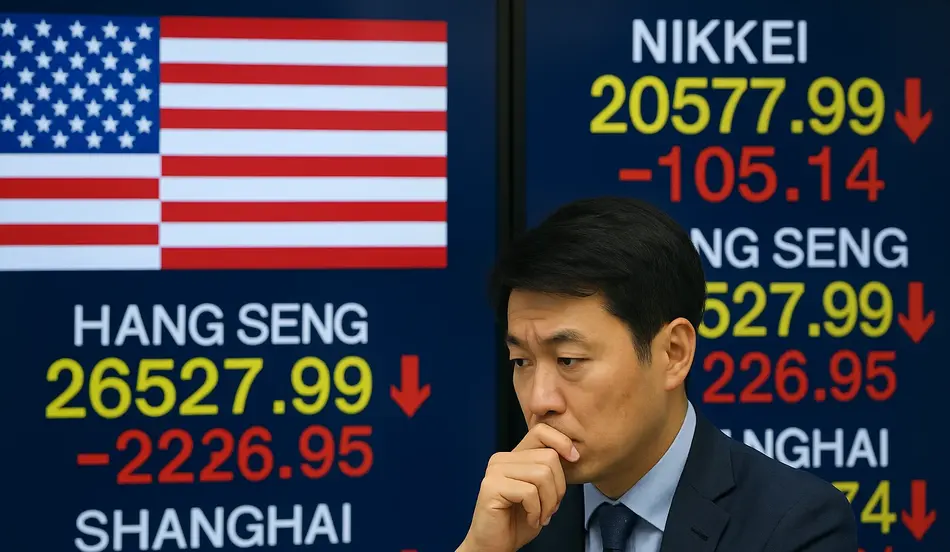Asia trade markets are experiencing significant volatility as President Trump’s aggressive tariff policies collide with mounting government shutdown fears, creating a perfect storm of uncertainty that’s reshaping global trade dynamics. From Tokyo to Sydney, markets are grappling with the dual threats of escalating trade tensions and potential economic data disruptions that could fundamentally alter investment strategies across the region.
The latest developments reveal a complex web of interconnected challenges. Trump’s announcement of 100% tariffs on films made outside the United States, combined with 30% levies on furniture and 10% duties on softwood lumber imports, has sent shockwaves through Asian markets already struggling with currency fluctuations and geopolitical tensions.
The timing couldn’t be worse for Asia’s export-dependent economies. With the U.S. government shutdown looming on Wednesday, crucial economic data releases including Friday’s nonfarm payrolls report could be delayed, creating additional uncertainty for traders and investors who rely on these indicators to make critical decisions about Asian market exposure.
The impact extends far beyond simple tariff calculations. These policies are fundamentally reshaping supply chains, forcing companies to reconsider their manufacturing strategies, and creating new winners and losers in the global trade landscape. For Asian economies that have built their growth models on export-oriented manufacturing, the implications are profound and potentially devastating.
The Tariff Tsunami: A Multi-Front Trade War
Trump’s latest tariff announcements represent a significant escalation in his trade policy approach, targeting multiple industries simultaneously and creating unprecedented uncertainty for Asian exporters. The 100% tariff on overseas films, 30% levy on furniture, and 10% duty on softwood lumber imports demonstrate a comprehensive approach to trade protectionism that goes far beyond traditional economic considerations.
The film industry tariff is particularly concerning for Asian markets, as it directly targets one of the region’s most successful cultural exports. Sony, with its significant presence in both the movie industry and Tokyo markets, faces immediate pressure as investors assess the potential impact on the company’s entertainment division. The 100% tariff effectively doubles the cost of non-U.S. films, creating a massive competitive disadvantage for Asian content producers.
The furniture and lumber tariffs compound existing pressures on Asian manufacturers who have already been struggling with supply chain disruptions and rising material costs. These industries, often located in smaller Asian economies, lack the resources to quickly relocate production or absorb significant cost increases, making them particularly vulnerable to these policy changes.
The cumulative effect of these tariffs creates a cascading impact across Asian supply chains. Companies that rely on these industries for components or finished goods face increased costs, reduced competitiveness, and difficult decisions about whether to absorb the additional expenses or pass them on to consumers.
The Tariff Tsunami
A sweeping wave of tariffs is disrupting industries from film to furniture, reshaping global supply chains. Employers can weather the storm by hiring resilient talent ready to adapt, innovate, and navigate uncertainty. Post your job on WhatJobs today and connect with professionals prepared to strengthen your business in turbulent markets.
Post a Job Free for 30 Days →Government Shutdown: The Data Drought Crisis
The looming U.S. government shutdown presents a different but equally significant challenge for Asian markets. The potential delay of crucial economic data releases, particularly Friday’s nonfarm payrolls report, creates a dangerous information vacuum that could lead to increased market volatility and poor investment decisions.
Asian traders and investors rely heavily on U.S. economic data to make informed decisions about currency exposure, interest rate expectations, and overall market direction. The nonfarm payrolls report, in particular, is a critical indicator that influences Federal Reserve policy decisions, which in turn affect global capital flows and currency valuations.
The shutdown threat comes at a particularly sensitive time for Asian markets. With the Bank of Japan considering a potential rate hike in October and the Reserve Bank of Australia holding its key rate decision, the lack of reliable U.S. data could lead to mispriced assets and increased market inefficiencies.
The psychological impact of the shutdown extends beyond data availability. The perception of U.S. political instability can lead to risk-off sentiment that disproportionately affects emerging Asian markets, which are typically more sensitive to global risk appetite than developed economies.
Currency Markets: The Yen’s Delicate Balance
The Japanese yen’s recent strength highlights the complex interplay between domestic monetary policy and global trade tensions. The Bank of Japan’s potential October rate hike, combined with Trump’s tariff announcements, has created a delicate balancing act for currency traders and policymakers.
The yen’s strength against the U.S. dollar reflects both expectations of tighter Japanese monetary policy and safe-haven demand driven by global uncertainty. However, this strength creates challenges for Japanese exporters, who face both higher tariffs on their U.S. sales and reduced competitiveness due to currency appreciation.
The situation is further complicated by the Bank of Japan’s internal divisions. With some board members advocating for patience and others pushing for immediate action, the central bank’s decision-making process has become increasingly complex. The summary of opinions from the September meeting reveals a split between those who want to avoid market surprises and those who see upside price risks as justification for immediate action.
For Japanese companies, the combination of tariff pressures and currency strength creates a perfect storm of challenges. Those with significant U.S. exposure must navigate both increased costs from tariffs and reduced revenue from currency translation effects, forcing difficult decisions about pricing, production, and market strategy.
The Semiconductor Showdown: Huawei vs. NVIDIA
The ongoing semiconductor competition between Huawei and NVIDIA highlights the broader technological and geopolitical tensions affecting Asian markets. Huawei’s ambitious plan to ramp up production of its Ascend 910C AI chips to 600,000 units by 2026 represents a significant challenge to NVIDIA’s dominance in the Chinese market.
This development is particularly significant because it demonstrates China’s ability to work around U.S. sanctions and develop competitive alternatives to restricted technologies. Huawei’s success in improving production yields and expanding capacity suggests that the U.S. strategy of restricting access to advanced semiconductor technology may be less effective than initially anticipated.
The implications extend far beyond the semiconductor industry. If Chinese companies can successfully develop and scale competitive alternatives to U.S. technologies, it could fundamentally alter the global technology landscape and reduce the effectiveness of U.S. trade restrictions as a policy tool.
For investors, this creates both opportunities and risks. Chinese technology companies that can successfully navigate these challenges may offer significant upside potential, while U.S. companies that rely heavily on Chinese markets face increased competitive pressure and regulatory uncertainty.
The Semiconductor Showdown
The battle between Huawei and NVIDIA signals a seismic shift in the global tech landscape, with semiconductors at the center of innovation and geopolitics. Employers in tech and manufacturing can seize this moment by hiring talent ready to drive breakthroughs in AI, chips, and advanced systems. Post your job on WhatJobs today and connect with professionals building the future of technology.
Post a Job Free for 30 Days →Market Reactions: Safe Havens and Risk Assets
The market reactions to these developments reveal the complex risk-return dynamics affecting Asian markets. Gold prices hitting record highs reflect safe-haven demand driven by both trade tensions and government shutdown fears, while oil prices remain under pressure due to expectations of increased OPEC+ production.
The divergence between safe-haven assets and risk assets highlights the bifurcated nature of current market conditions. While some investors seek protection in traditional safe havens, others continue to pursue growth opportunities in technology and emerging markets.
This divergence creates opportunities for sophisticated investors who can navigate the complex risk landscape, but it also increases the potential for significant losses for those who misread market signals or fail to properly hedge their exposures.
The situation is further complicated by the interconnected nature of global markets. A shock in one market or region can quickly spread to others, creating cascading effects that are difficult to predict or manage.
Frequently Asked Questions
Asia trade markets – how are they responding to Trump’s latest tariffs?
Asia trade markets are experiencing significant volatility as Trump’s tariffs on films (100%), furniture (30%), and lumber (10%) create uncertainty for export-dependent economies, forcing companies to reconsider supply chains and pricing strategies.
What impact will the U.S. government shutdown have on Asian markets?
The potential government shutdown threatens to delay crucial economic data releases like nonfarm payrolls, creating an information vacuum that could increase market volatility and lead to poor investment decisions across Asian markets.
How are currency markets responding to these trade tensions?
The Japanese yen has strengthened due to safe-haven demand and expectations of Bank of Japan rate hikes, while the U.S. dollar faces pressure from government shutdown fears and tariff concerns, creating complex dynamics for Asian exporters.
What does Huawei’s semiconductor expansion mean for Asian markets?
Huawei’s plan to ramp up Ascend 910C AI chip production to 600,000 units by 2026 challenges NVIDIA’s dominance and demonstrates China’s ability to work around U.S. sanctions, potentially reshaping global technology supply chains.
What strategies should Asian companies adopt to navigate these challenges?
Asian companies should diversify supply chains, reduce dependence on single markets, invest in technology and innovation, develop more flexible business models, and focus on building competitive advantages that can withstand trade disruptions.
A Real-World Example: The Manufacturing Executive’s Dilemma
Sarah Chen, a manufacturing executive at a mid-sized electronics company in Taiwan, faces the perfect storm of challenges created by Trump’s tariff policies and global market uncertainty. “We’ve been supplying components to U.S. furniture manufacturers for over a decade,” she explains. “The 30% tariff on furniture means our customers are looking at 30% higher costs, and they’re asking us to absorb some of that.”
Sarah’s company, which employs 500 people and generates 60% of its revenue from U.S. customers, must make difficult decisions about pricing, production, and market strategy. “We can’t simply pass on all the costs to our customers because they’ll look for alternatives,” she says. “But we also can’t absorb all the additional costs without significantly impacting our profitability.”
The situation is further complicated by currency fluctuations and supply chain disruptions. “The yen’s strength is affecting our Japanese suppliers, which increases our costs,” Sarah explains. “And the uncertainty about government shutdowns makes it difficult to plan for the future because we don’t know when we’ll get reliable economic data.”
Sarah’s response has been to diversify her customer base and invest in automation to reduce costs. “We’re expanding into European and Southeast Asian markets,” she says. “We’re also investing in robotics and AI to improve efficiency and reduce our dependence on labor costs.”
The experience has taught Sarah the importance of building resilient business models. “You can’t rely on any single market or customer,” she says. “You need to be able to adapt quickly to changing conditions and have multiple options for growth.”
Sarah’s advice to other Asian manufacturers reflects the lessons she’s learned. “Don’t put all your eggs in one basket,” she says. “Diversify your markets, invest in technology, and build strong relationships with customers who value your capabilities rather than just your price.”
Sarah’s story demonstrates that while the current challenges are significant, they also create opportunities for companies that can adapt and innovate. Those that can successfully navigate these turbulent waters may emerge stronger and more competitive than before.
Don’t Let Trade Tensions Derail Your Investment Strategy
The Asia trade markets are facing unprecedented challenges from Trump’s tariff policies and government shutdown fears, but these challenges also create opportunities for savvy investors and companies that can adapt to changing conditions.
The key to success in this environment is to focus on companies and sectors that can demonstrate resilience, innovation, and competitive advantages that can withstand trade disruptions. This means looking for businesses with diversified revenue streams, strong technological capabilities, and flexible business models.
For Asian companies, the path forward requires investment in technology, diversification of markets and customers, and development of competitive advantages that go beyond simple cost advantages. Those that can successfully navigate these challenges will emerge stronger and more competitive.
The current environment also highlights the importance of staying informed about policy developments and market conditions. With trade policies changing rapidly and market conditions evolving quickly, investors and companies must be prepared to adapt their strategies as new information becomes available.
The future of Asian markets will depend on their ability to innovate, adapt, and compete in an increasingly complex global environment. Those that can successfully navigate these challenges will thrive, while those that cannot may face significant disruption.




